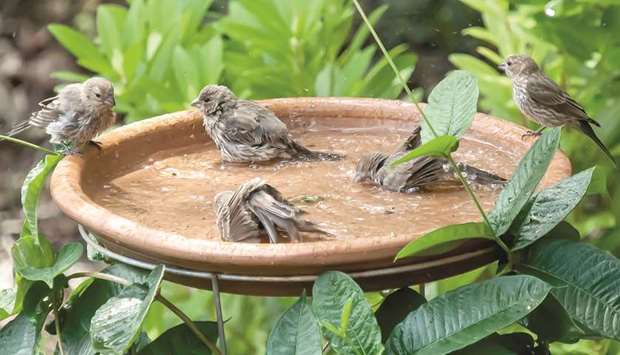Two old tomato cages and a couple of rescued terra cotta saucers have made the Garden Guy’s yard a ‘Finch Riviera.’ It hasn’t been just finches but a host of birds. As a horticulturist I am pretty much up on plants that birds eat and have become fairly proficient with the feeder aspect like I suppose as many of you are.
The question is whether you have accomplished the water aspect of the backyard habitat. One thing that really stressed me while I was director of the National Butterfly Centre was that it was paramount for the birds to have water.
David and Jan Dauphin were the volunteer managers of the birding area of the butterfly centre and developed a three-fountain system from which water dripped 24 hours a day and then gently ran out of the fountain to terra cotta saucers on the ground below. Even though the Rio Grande was close by, as were irrigation canals, it was apparent that both the fountains and the saucers below provided ample water to the birds.
I’ve been working on a new home and landscape and my feeders were immediately bringing in the birds. It makes you wonder how they knew so fast. Even though I have a flowing creek, I knew from lessons learned that I needed to provide a source of water. Admittedly the ‘The Garden Guy’ does things on the cheap and I think my idea was a home run. Everything was created from things around the house.
As I write I have two birdbaths not only frequented by birds, but also provided flowers for months. The recipe was two old large tomato cages and two old terra cotta saucers I found in a field. I did purchase two 1-gallon mandevillas from the discount garden graveyard section of a box store.
You get the idea: the cages went in the ground, the saucers placed on top and one mandevilla in the ground in the centre of each cage. The mandevillas immediately took off as if rewarding me for giving them attention. It wasn’t long before the birds took notice and visited the saucers for drinking, bathing and splashing.
The maintenance is not hard as I’ll head out to the baths with a watering can and paper towels and in a minute things are always presentable to the feathered friends. Sometimes when I water plants I’ll also send some spray into the saucers with the water wand to freshen up. The mandevillas quickly climbed each of the segments of the cage, encouraging me do a little weaving of the vines to train the direction of their growth.
It has been thrilling to see bright yellow American goldfinches, American robins, mourning doves, nuthatches, chickadees and a riotous saucer full of house finches all splish-splashing together. Then a couple of weeks a go it was a celebratory high five with my wife when a hooded warbler visited. The point is you need to provide water with your feeding activities and it doesn’t have to be expensive to work. When you’re choosing a birdbath, look for one with a basin that you can clean easily. It should also have a gentle slope to allow birds to wade into the water. You can make your own bath out of a garbage can lid, a saucer-type snow sled, or even an old frying pan. But if you’d rather buy one, look for a birdbath made of tough plastic that won’t break if the water freezes or if your dog knocks it over.
For the ultimate birdbath, set up a permanent pool in your backyard. Just dig a shallow hole in the ground and line it with plastic or cement to make it watertight. Plant ferns and other native plants around the pool to make it more attractive. You can add a pump to circulate the water if you want to create elaborate multi-level pools.
All you need is probably your garage or storage shed. With just a little maintenance and fresh water, your backyard wildlife habitat will become more beautiful and essential to visiting birds.– TNS

AMPLIFIED: Five finches make this bird bath a ‘Finch Riviera.’


